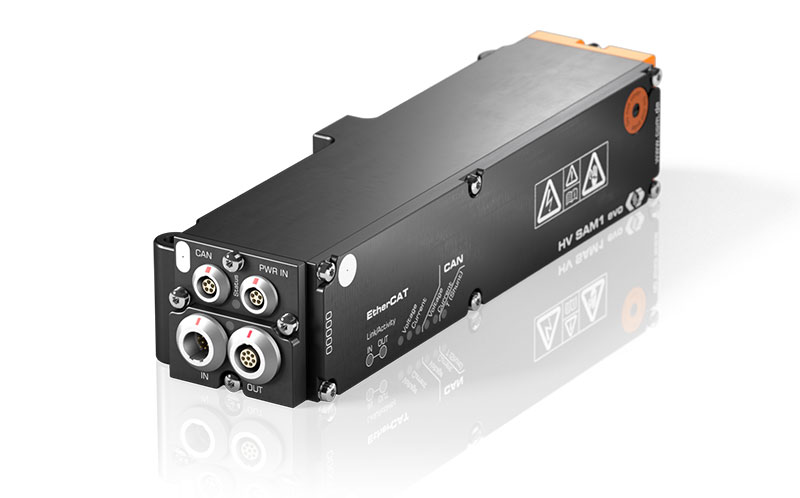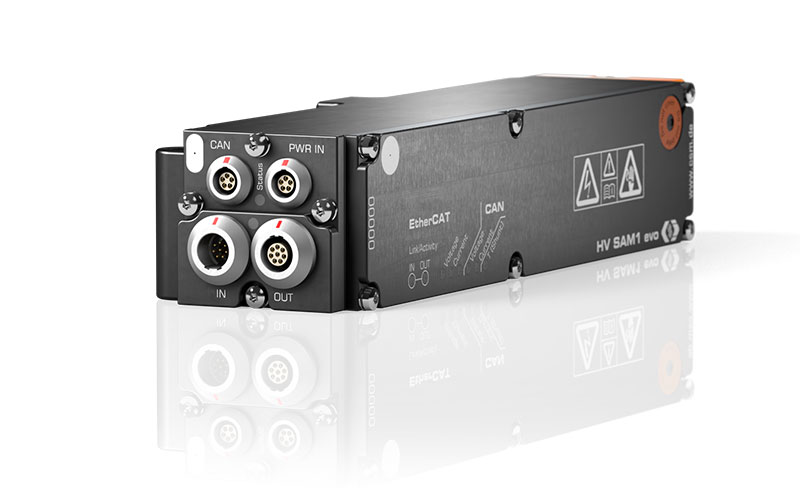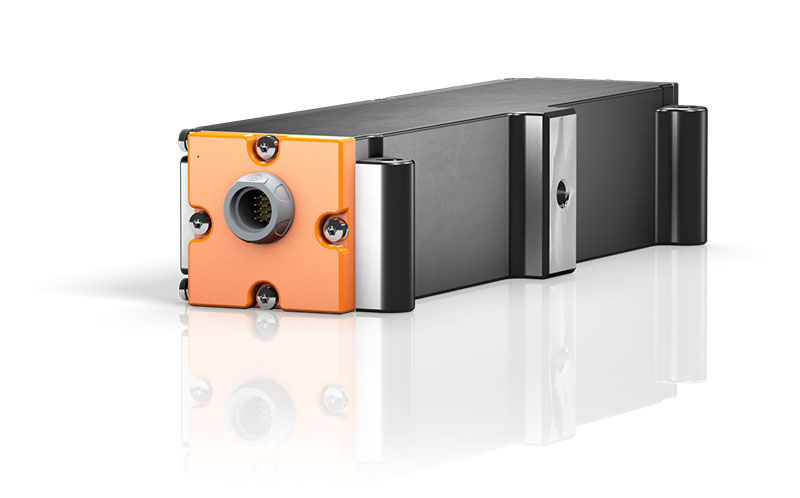HV SAM1 evo
Measurement module for single-phase current and voltage measurement
The HV SAM1 evo acquires the current and voltage values of the HV SBM evo and also performs the filtering, calculation of effective values and power, as well as the data output via EtherCAT® and CAN.
Highlights
- Current and voltage measurement in HV applications
- Currents up to ±1,000 A (rated ), ±2,000 A (peak)
- Voltages up to ±1,000 V (measurement range up to ±2,000 V)
- Simultaneous EtherCAT® and CAN bus communication
- Output of voltage, current and instantaneous power with up to 1 MHz measurement data rate each
- Optional calculation of power and RMS values directly in the module and output via CAN
- In-depth online power analysis with the Vector eMobilityAnalyzer software
Desciption
The separation of the HV SBM evo or HV SBML evo and the HV SAM1 evo measurement module allows the elements to be arranged separately. While the breakout boxes integrate almost perfectly into the HV cables due to their design, the measurement module does not have to be installed directly at the measurement point.
The HV SBM_I evo or HV SBML_I evo is connected to the measurement module via a HV-safe and shielded sensor cable. The sensor cable also supplies the measurement electronics in the shunt module of the HV SBM_I evo or HV SBML_I evo. The HV SBM_U evo or HV SBML_U evo or a suitable sensor cable for the HV voltage tap is connected to the HV SBM_I evo or HV SBML_I evo.
The HV SAM1 evo measurement module is used for data acquisition, filtering and for calculating effective values and power. In addition, the encapsulated housing and galvanic isolation ensure HV safety for users and components.
Currents are measured in the corresponding HV SBM_I evo or HV SBML_I evo. The voltage measurement is carried out in the HV SAM 1 evo with the measured HV+ and HV- potentials (HV+ is tapped via HV SBM_U evo, HV SBML_U evo or sensor cable).
The measurement data is passed on via EtherCAT® and CAN bus.
Calculation of power and RMS values
With the Option Calculated Channels the active, apparent and reactive power, power factor as well as the RMS values to be calculated directly in the module from the sampled measurement values. The calculated values are passed on to the measurement computer or a data logger via CAN.
Technical Data
| HV SAM1 evo | ||
|---|---|---|
| Inputs | 1 x voltage signal, 1 x current signal | |
| Number of measured phases | 1 | |
| Measurements signals | Inner conductor current and voltage | |
| Inner conductor current (Nominal) |
±50 to ±1,000 A Four configurable measurement ranges, depending on shunt module used. See data sheet. |
|
| Voltage | ±100, ±200, ±500, ±1,000, ±2,000 V For the acquisition of transient overvoltage, the measuring range is dimensioned to ±2,000 V. |
|
| Measurement data rate | ||
| ECAT | 1, 2, 5, 10, 20, 50, 100, 200, 500, 1,000, 2,000 kHz | |
| CAN | 1, 2, 5, 10, 20, 50, 100, 200, 500 Hz, 1, 2, 5, 10 kHz | |
| Output signals | ||
| ECAT | Voltage, current, instantaneous power | |
| CAN | Voltage, current With Option Calculated Channels additionally: RMS values for voltage and current, active power, apparent power, reactive power and power factor Lambda |
|
| Integration time RMS value and power calculation | 10 ms to 10 s | |
| Measurement categories | ||
| CAT 0 | 1,000 V | |
| CAT II | 600 V | |
| CAT III | 300 V | |
| Operating conditions | ||
| Housing protection class | IP67 | |
| Operating temperature range | -40°C up to +120°C | |
| Pollution degree | 4 | |
| Safety conformity | EN 61010-1:2020 | |
Applications
The HV BM-Split evo can be flexibly integrated into the measurement points thanks to the separate design of the sensor modules and measurement module.
The direct output of power and RMS values allows various analyses without the use of special hardware and software in road tests. More in-depth analyses, such as signal ripple and correlation with measured values from other CSM measurement modules (e.g. temperatures), can be carried out with the Vector CSM E-Mobility Measurement System.
Further Information
-
CSM Xplained: Testing of fuel cell drives on test benches and in road testing
-
CSM Xplained: Maintenance of HV measurement technology – calibration and insulation-test
-
CSM Xplained: The Vector CSM E-Mobility Measurement System
-
CSM Xplained: Voltage measurement in e-mobility
-
CSM Xplained: Current measurement in e-mobility
-
CSM Xplained: Autonomous power measurement in road tests and on test benches
Downloads
- Configuration software for CSM measurement modules (incl. documentation)
- with visualization software CSMview
- System requirements:

 Home
Home Newsletter
Newsletter










